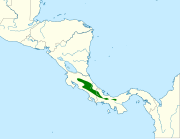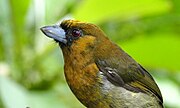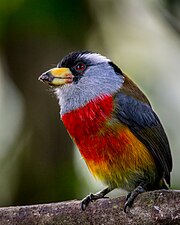| Toucan-barbets | |
|---|---|

| |
| Toucan barbet (Semnornis ramphastinus) | |
| Scientific classification | |
| Domain: | Eukaryota |
| Kingdom: | Animalia |
| Phylum: | Chordata |
| Class: | Aves |
| Order: | Piciformes |
| Suborder: | Pici |
| Infraorder: | Ramphastides |
| Family: | Semnornithidae Prum, 1988 |
| Genus: | Semnornis Richmond, 1900 |
| Species | |
| Synonyms | |
|
Pan (preoccupied) | |
The toucan barbets are the small birds in the genus Semnornis. This was often included in the paraphyletic barbets but recently usually considered a distinct family Semnornithidae; alternatively, all barbets might be moved to the toucan family Ramphastidae as a subfamily, Semnornithinae. It contains only two species, the toucan barbet (S. ramphastinus) and the prong-billed barbet (S. frantzii).
Taxonomy
The phylogenetic relationship between the toucan barbets and the eight other families in the order Piciformes is shown in the cladogram below. The number of species in each family is taken from the list maintained by Frank Gill, Pamela C. Rasmussen and David Donsker on behalf of the International Ornithological Committee (IOC).
| Piciformes |
| ||||||||||||||||||||||||||||||||||||||||||||||||
Description
The Semnornis barbets are fairly large barbets, measuring between 18 and 21 cm (7.1 and 8.3 in). The toucan barbet is larger than the prong-billed barbet and considerably heavier. They possess large, swollen bills and lack strong sexual dimorphism in their plumage. The plumage of the prong-billed barbet is orange-brown, and that of the toucan barbet is more distinctively patterned with black, red, grey and gold.
Distribution and habitat
The Semnornis toucan-barbets are found in the Neotropics. The prong-billed barbet is restricted to the humid highland forests of Costa Rica and Panama. The toucan barbet is found in similar habitats in the western montane forests of Ecuador and Colombia. In addition to primary forest they may occupy forest edges and secondary growth. Neither species is migratory, and young birds do not appear to disperse very far after fledging; young toucan barbets only disperse 0.5 km.
Behaviour
The Semnornithidae are highly social, and may be seen either in small groups of up to five or six individuals, or as singles. They are active during the day and are early risers. The prong-billed barbet sleeps in communal roosts at night in the non-breeding season. As many as 19 birds may roost together in a hole, either a modified nest or the abandoned nest of a woodpecker. During the breeding season pairs roost in their own nests.
Diet and feeding
The diet of these two species is made up of fruits and insects. The ratio of the two is more similar to the toucans than other barbets and is dominated by fruits. A 1993 study of the stomach contents of these two species found only fruit. Fruits may be eaten whole, held in the foot and broken and eaten, or crushed and only the juices eaten. Insects are more common in the diet of nestlings, and compose 40% of the food brought to the nest in toucan-barbets. Toucan-barbets may also feed their chicks small numbers of vertebrates. They have also been recorded eating flowers.
Breeding
Both species of toucan-barbet are monogamous breeders. Prong-billed barbets defend breeding territories from all others of their species. Toucan barbets, on the other hand, have territories but are helped in raising the young by helpers.
Species
| Common name | Scientific name and subspecies | Range | Size and ecology | IUCN status and estimated population |
|---|---|---|---|---|
| Prong-billed barbet | Semnornis frantzii (Sclater, PL, 1864) |
Costa Rica and western Panama
|
Size: Habitat: Diet: |
LC
|
| Toucan barbet | Semnornis ramphastinus (Jardine, 1855) |
western Ecuador and Colombia
|
Size: Habitat: Diet: |
NT
|
References
- Richmond, Chas (1899). "New Name for the Genus Tetragonops" (PDF). Auk. 16 (1): 77.
- Richmond, Charles W. (1900). "Some Necessary Changes in Nomenclature". Auk. 17 (2): 178–179. doi:10.2307/4069180. JSTOR 4069180.
- Kuhl, H.; Frankl-Vilches, C.; Bakker, A.; Mayr, G.; Nikolaus, G.; Boerno, S.T.; Klages, S.; Timmermann, B.; Gahr, M. (2021). "An unbiased molecular approach using 3′-UTRs resolves the avian family-level tree of life". Molecular Biology and Evolution. 38 (1): 108–127. doi:10.1093/molbev/msaa191. hdl:21.11116/0000-0007-B72A-C. PMC 7783168. PMID 32781465.
- Stiller, J.; et al. (2024). "Complexity of avian evolution revealed by family-level genomes". Nature. 629 (8013): 851–860. Bibcode:2024Natur.629..851S. doi:10.1038/s41586-024-07323-1. PMC 11111414. PMID 38560995.
- Gill, Frank; Donsker, David; Rasmussen, Pamela, eds. (December 2023). "IOC World Bird List Version 14.1". International Ornithologists' Union. Retrieved 17 June 2024.
- ^ Horne, J; Short, L (2002). "Family Capitonidae (Barbets)". In del Hoyo, Josep; Elliott, Andrew; Sargatal, Jordi (eds.). Handbook of the Birds of the World. Volume 7, Jacamars to Woodpeckers. Barcelona: Lynx Edicions. pp. 218–219. ISBN 978-84-87334-37-5.
- Ripley, S Dillon (1945). "The Barbets". The Auk. 62 (4): 542–563. doi:10.2307/4079804. JSTOR 4079804.
- ^ Skutch, Alexander (1944). "The Life-History of the Prong-Billed Barbet". Auk. 61 (1): 61–88. doi:10.2307/4079597. JSTOR 4079597.
- Remsen Jr., J.V.; Hyde, Mary Ann; Chapman, Angela (1993). "The Diets of Neotropical Trogons, Motmots, Barbets and Toucans". The Condor. 95 (1): 178–192. doi:10.2307/1369399. JSTOR 1369399.
- Restrepo, Carla; Monddragon, Marta (1998). "Cooperative Breeding in the Frugivorous Toucan barbet (Semnornis ramphastinus)" (PDF). The Auk. 115 (1): 4–15. doi:10.2307/4089106. JSTOR 4089106.
Further reading
- Edinburgh New Philosophical Journal, (New series) 2 no.2 p. 404
External links
- Barbet videos on the Internet Bird Collection
- Don Roberson's Bird Families of the World
| Order: Piciformes | |
|---|---|
| Suborder | Family |
| Galbuli |
|
| Pici |
|
| Taxon identifiers | |
|---|---|
| Semnornis | |









